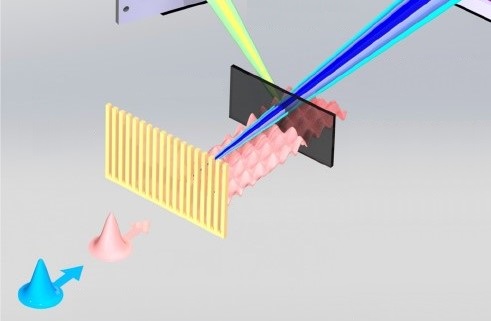Peering into matter with ultrashort X-ray ripples
03.07.2025
 |
|
Experimental geometry of the All X-ray Transient Grating experiment. Image: Cristian Svetina. |
- A team of researchers led by Cristian Svetina at IMDEA Nanociencia have designed an all X-ray transient grating experiment.
- Scientist can now study the dynamics of quantum particles at the nanoscale, with transient gratings of the order of nanometres.
- The broad collaboration among 22 institutions includes the measurement in X-Ray facility SACLA FEL (Japan).
| Tweet |
Madrid, July 3rd, 2025. To understand how heat or charge move through materials—whether in gases, liquids, or solids—scientists need to observe the tiniest changes in space and time. One powerful tool for this is called transient grating spectroscopy, which uses the interference of two pulses of light to create a microscopic grating on a material’s surface. The grating excites the material with a controllable spatial periodicity and a probe pulse of light is used to monitor the dynamics of the excitation. Traditionally, this technique has used visible or infrared light, limiting its resolution to gratings about a micron apart. But many of the most interesting behaviors in materials happen on even smaller scales, just few to tens of nanometers wide, where particles behave differently as they move between random (diffusive) and straight-line (ballistic) paths.
Recent advances have pushed transient grating spectroscopy into new territory using shorter-wavelength light. Hard X-ray beams—made possible by next-generation light sources known as Free-Electron Lasers—can now create much finer gratings, allowing scientists to probe the nanoscale. However, previous attempts using hard X-rays have relied on hybrid approaches, where the X-rays created the grating but optical light was still used to measure it. This mismatch made it harder to fully benefit from the precision of X-rays.
Now, researchers have demonstrated an all-X-ray transient grating technique using hard X-ray pulses for both creating and probing the grating. These pulses are just a few femtoseconds long (a millionth of a billionth of a second) and allow scientists to track ultrafast processes with extraordinary detail. In order to generate transient gratings with hard X-ray beams, the Talbot effect was used avoiding complex optical schemes. A single beam interferes with itself at the Talbot distances, forming interference ripples termed “Talbot carpet”. The team tested their method on two materials: an amorphous iron-gadolinium alloy and a thin crystalline layer of silicon. In both materials they captured the evolution of coherent optical phonons, or vibrations of the atomic lattice.
This work contains a number of breakthroughs: a) evidence of all hard X-ray TG spectroscopy on two different types of materials is demonstrated; b) demonstration of self-diffraction TG’s in the hard X-ray regime; c) scanning the time between the two hard X-ray pulses, revealing interesting and exciting phonon dynamics; d) a direct correlation between the all hard X-ray TG signal and the X-ray diffraction is observed. These results are remarkable as they establish a new experimental method to investigate nanoscale phenomena in functional materials such as miniaturized thermal devices, sensors, superconductors, ultrafast magnetic switches, photocatalysts and ultrafast data storage elements.
This new approach, published in Communications Physics, opens the door to studying the most fundamental processes in materials with unprecedented spatial and temporal resolution. From exploring how heat flows through a microchip to revealing the dynamics of phase transitions in quantum materials, this first demonstration of all hard X-ray transient grating spectroscopy identifies key factors that could unlock previously inaccessible spatial regions, potentially advancing the transient grating approach for nanoscale dynamics in condensed matter systems.
This work has been coordinated by Cristian Svetina at IMDEA Nanociencia, and is a broad collaboration between research groups at DESY Hamburg, Paul Scherrer Institut (Switzerland), University of Bern, RIKEN Institute (Japan), Elettra Sincrotrone (Italy), DECTRIS, Universita degli Studi di Milano, CNR-IOM (Italy), PWGP Labs, ETH Zurich, Japan Synchrotron, Argonne National Laboratory (USA), Universidad Politécnica de Cataluña (Spain), Osaka University, Institute for Molecular Science (Okazaki, Japan), Stockholm University, Ecole Politechnique Federale de Laussane, the Madrid Institute for Advanced Studies in Nanoscience (IMDEA Nanociencia) and the European XFEL. The work is partially funded by the accreditation Excellence Severo Ochoa awarded to IMDEA Nanociencia (CEX2020-001039-S).
Glossary:
- Transient Grating (TG) Spectroscopy: transient grating spectroscopy is a time-resolved ‘four-wave’ mixing technique in which two optical pump pulses are crossed in the sample to create a spatially periodic excitation, whose dynamics are monitored via diffraction of a probe pulse (or a continuous wave beam).
- Talbot Effect: An optical phenomenon in which a periodic light pattern (like one made by a grating or mask) recreates itself at regular distances as it propagates. The regular distance is called the Talbot length, and the repeated images are called Talbot images. At small regular fractions of the Talbot length, sub-images can also be observed, forming a fractal pattern often referred to as “Talbot carpet”.
Reference
Eugenio Ferrari, Hiroki Ueda et al. All hard X-ray transient grating spectroscopy. Communications Physics 2025. DOI: 10.1038/s42005-025-02178-y
![]() Link to IMDEA Nanociencia Repository: https://hdl.handle.net/20.500.12614/4021
Link to IMDEA Nanociencia Repository: https://hdl.handle.net/20.500.12614/4021
Contact:
Cristian Svetina
cristian.svetina at imdea.org
X-ray Wave-mixing Spectroscopies (X-WaveS) Group
https://nanociencia.imdea.org/x-ray-wave-mixing-spectroscopies-x-waves/home
Oficina de Divulgación y Comunicación en IMDEA Nanociencia
divulgacion.nanociencia [at]imdea.org![]()
![]()
![]()
![]()
![]()
Source: IMDEA Nanociencia
IMDEA Nanociencia Institute is a young interdisciplinary research Centre in Madrid (Spain) dedicated to the exploration of nanoscience and the development of applications of nanotechnology in connection with innovative industries.




